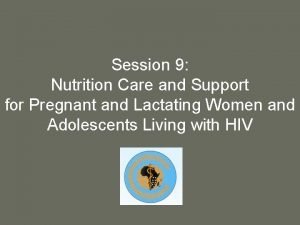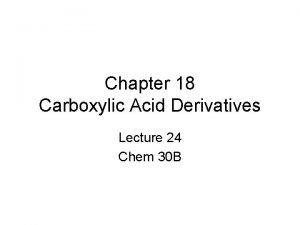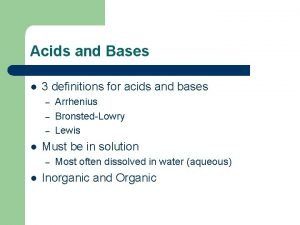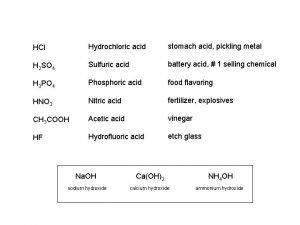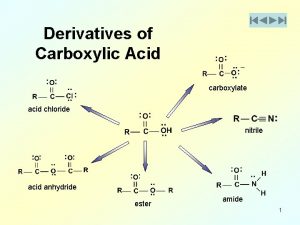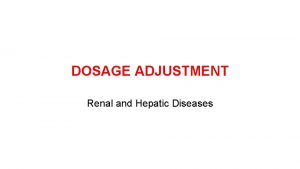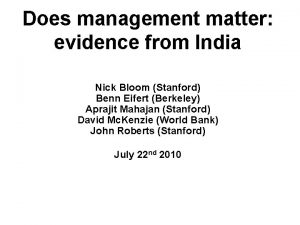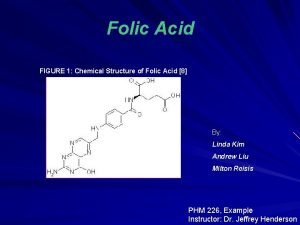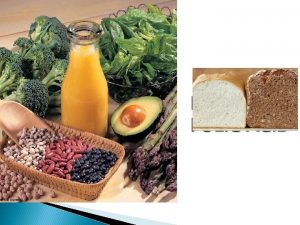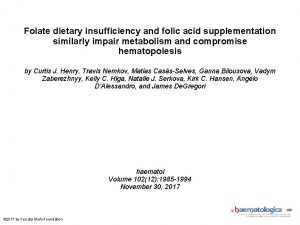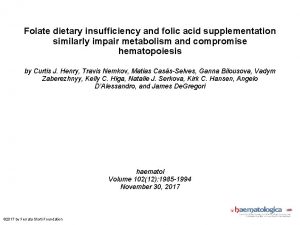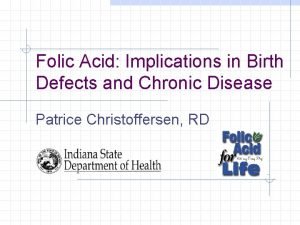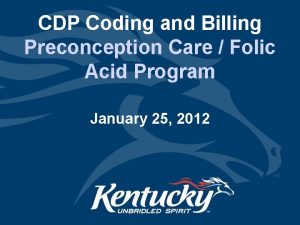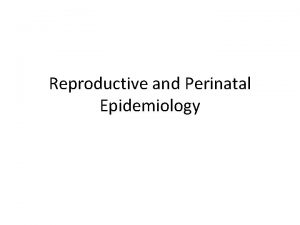Folic Acid Fortification and Supplementation Does Dose Matter


































- Slides: 34

Folic Acid Fortification and Supplementation: Does Dose Matter? Nicholas Wald Wolfson Institute of Preventive Medicine, London Folic Acid and the Prevention of Neural Tube Disorders The Royal Society of Medicine 7 th May 2003

MRC vitamin study: effect of folic acid Wald et al. Lancet 19912

Folic acid: on-treatment analysis Analysis restricted to women known not to be pregnant at randomisation and who took their capsules Wald et al. Lancet 19913

Other vitamins – no significant effect (A, D, B 1, B 2, B 6, C and nicotinamide) Wald et al. Lancet 19914

Folic Acid and Neural Tube Defects

1. What is the dose-response relationship between change in folic acid intake and change in NTD risk? 2. Is there an intake that will prevent nearly all NTDs and if so what is it?

The problem It is difficult to specify a simple doseresponse relationship between folic acid intake and NTD risk. For example, in some places taking a given amount of folic acid has a small effect but in other places has a large effect. A two-stage model appears to solve the problem.

Dose-response relationships 1. Folic acid intake and blood folate levels 2. Blood folate and neural tube defect risk 8

Increase in serum folate according to increase in folic acid intake

An extra 0. 1 mg folic acid intake increases serum folate by about 1. 0 ng/ml in the age group 20 – 35

Dose-response relationships 1. Folic acid intake and blood folate levels 2. Blood folate and neural tube defect risk

NTD prevalence according to plasma/serum folate 12

NTD Relative Risk = ( New serum folate Old serum folate ( New serum folate ( Old serum folate New serum folate – 0. 81 ) – 1 ) )

Relative Risk of having an NTD pregnancy according to relative change in maternal serum folate level Relative change in serum folate 1. 0 Relative NTD risk 1. 00 1. 5 0. 67 (1/1. 5) 2. 0 0. 50 (1/2) 2. 5 0. 40 (1/2. 5) 5. 0 0. 20 (1/5) 10. 0 0. 10 (1/10) (with correction for regression dilution bias)

Two important dose-response relationships 1. Dietary folic acid and serum folate This is additive – i. e. an extra 0. 1 mg folic acid adds an extra 1. 0 ng/ml to a person’s serum folate 15

Two important dose-response relationships 1. Dietary folic acid and serum folate This is additive – i. e. an extra 0. 1 mg folic acid adds an extra 1. 0 ng/ml to a person’s serum folate 2. Serum folate and neural tube defect risk This is proportional – i. e. a doubling in serum folate halves neural tube defect risk 16

Dose-Response Relation between Folic Acid and NTDs Increase in Folic Acid Intake (baseline of serum folate 5 ng/ml) 0 0. 2 0. 4 0. 8 1. 0 4. 0 5. 0 Percentage of NTDs preventable 0 23 36 52 57 82 85 Effect of an extra 0. 2 mg Effect of an extra 1 mg 23% 57% 5% 3% Wald et al. Lancet 200117

Effect of Background Serum Folate Background serum folate (ng/ml) Percentage of NTDs preventable by an 0. 8 mg/day increase in folic acid intake 2. 5 67% 5 52% 10 36% 18

Dose-Response Conclusions • • Continuous proportional reduction in NTD risk with increasing folic acid intake Preventive effect inversely related to background folate Practical fully effective dose is 5 mg/day This will reduce NTD risk by 85% if background serum folate is 5 ng/ml 19

Folic acid supplements • All women planning a pregnancy should take a 5 mg folic acid supplement daily and start before becoming pregnant • This should be available without a prescription • A two-dose policy (0. 4 mg v 5 mg) according to family history of an NTD pregnancy is inappropriate 20

Folic acid and cardiovascular disease The minimum fully effective dose of folic acid on lowering serum homocysteine is about 0. 8 mg/day This reduces serum homocysteine by about 3μmol/l

Risk of cardiovascular disease for specified changes in serum homocysteine Disorder Ischaemic heart disease Stroke Deep vein thrombosis (with or without pulmonary embolism) Meta-analysis of studies Odds ratio for 3 mol/l homocysteine Cohort MTHFR decrease 16 46 0. 84 (0. 74 -0. 89) Risk reduction 16% 8 7 0. 76 (0. 67 -0. 85) 24% -- 26 0. 75 (0. 62 -0. 92) 25% Wald, D, Law & Morris, 2002 BMJ. com 22

Folic acid fortification This will help prevent cardiovascular disease as well as NTDs About half of all pregnancies are not planned although most are wanted. Many women are not aware of the need to take folic acid before pregnancy. Education campaigns are expensive, not very effective and need to be sustained (which they are not). Folic acid fortification should be regarded as an essential public health policy in all countries.

Target folic acid fortification level Approx % reduction IHD Stroke DVT NTD 15 25 25 • 5 mg/day too high 4 6 6 • 0. 2 mg/day minimum (0. 24 mg/100 g flour) 15 25 25 • 0. 8 mg/day probably right (1 mg/100 g flour) Will have full cardiovascular preventive effect (homocysteine 3μmol/l) Will prevent half of all NTDs. 85 25 50 24

Scale of benefit: World Neural tube defect pregnancies each year 500, 000 Preventable with 0. 2 mg extra folic acid per day 100, 000 Preventable with 0. 4 mg extra folic acid per day 200, 000 Preventable with 0. 8 mg extra folic acid per day 250, 000 25

Safety of Folic Acid Fortification • B 12 Neuropathy - not due to folic acid - no evidence of failure to detect B 12 neuropathy • Epilepsy - With fortification anticonvulsant control will be based on the background folic acid intake - Folic acid supplements of particular value because of high risk • Twins - No evidence of an increased risk (RR 0. 91, 95% CI 0. 81 -1. 00 China NTD study 2002) • Miscarriage - No evidence of an increased risk (RR 0. 97, 95% CI 0. 84 -1. 12 China NTD study 2001) 26

There is no evidence or reason to regard folic acid fortification at any of the doses proposed as posing a risk to health and there is compelling evidence that failure to fortify causes considerable harm

Costs of Folic Acid Fortification of Flour “The cost of the folic acid itself is about US $0. 15 per metric ton of flour. Total cash, folic acid, labour etc would be about US $0. 30 per metric ton” Dave Erickson Personal Communication November 2002 This is enough to feed 1 person for 30 years! -about 1 cent person per year -about $1000 per NTD pregnancy prevented 28

Countries that have fortified or have agreed to fortify Mandatory Voluntary Universal Agreed but not yet implemented Argentina Jordan Azerbaijan Brazil Bahrain Nicaragua Dominican Republic Fiji Belize Oman Haiti Iran Bolivia Panama Kazakhstan Israel Canada Paraguay Kyrgyz Republic Morocco Chile Qatar Mexico South Africa Colombia Saudi Arabia Mongolia Ukraine Costa Rica USA Tajikistan Cuba Venezuela Uzbekistan Ecuador El Salvador Guatemala 39 Countries Honduras Indonesia From Peter Ranum April 2003

No EU county has fortified

Conclusion of WHO/EURO Meeting Rome, 11 -12 November 2002 Recognising the severity of neural tube defects and the distress they cause, as well as the fact that they can be largely prevented by increasing the intake of folic acid without any indication of harm, member countries should consider, as a matter of urgency, the fortification of flour with folic acid on a mandatory basis.

“The failure of most countries to fortify foods with folic acid represents a major lost opportunity for improving health. ” Walter C Willett Meir J Stampfer N England J Med 2002; 346: 1915 32

“Governments that do not ensure fortification are committing public health malpractice” Godfrey Oakley BMJ, 2002; 324: 1348 -9

Conclusions • All countries should fortify flour with folic acid • The minimum level should be 0. 24 mg/100 g flour • Higher levels are preferred • There needs to be an international oversight group to guide policy and monitor the implementation of policies throughout the world 34
 Folic acid dose in pregnancy
Folic acid dose in pregnancy Folic acid mechanism of action
Folic acid mechanism of action Premix for fortification
Premix for fortification Personalised fortification
Personalised fortification Food delivery fortification
Food delivery fortification Mutual supplementation
Mutual supplementation Acid fast and non acid fast bacteria
Acid fast and non acid fast bacteria Acid fast vs non acid fast
Acid fast vs non acid fast What is the difference between gray and grey
What is the difference between gray and grey Brain falx
Brain falx Gray matter and white matter
Gray matter and white matter Telecephalon
Telecephalon 9-which acid is not considered a strong acid?
9-which acid is not considered a strong acid? Reaction of anhydride with alcohol
Reaction of anhydride with alcohol Lewis acid vs bronsted acid
Lewis acid vs bronsted acid Lewis acid bronsted acid
Lewis acid bronsted acid What are the 7 strong acids
What are the 7 strong acids Is chloric acid a strong acid
Is chloric acid a strong acid Acid proton donor or acceptor
Acid proton donor or acceptor Stomach acid vs battery acid
Stomach acid vs battery acid Nitriles to carboxylic acid
Nitriles to carboxylic acid Classification of matter section 1 composition of matter
Classification of matter section 1 composition of matter Composition of matter section 1
Composition of matter section 1 Chapter 2 matter section 1 classifying matter answer key
Chapter 2 matter section 1 classifying matter answer key Composition of matter section 1
Composition of matter section 1 Flow energy review
Flow energy review Medium dose ics and laba
Medium dose ics and laba Ionizing radiation examples
Ionizing radiation examples Benzodiazepine dose and route
Benzodiazepine dose and route Benzodiazepine receptor agonist
Benzodiazepine receptor agonist Loading dose formula
Loading dose formula Where does the citric acid cycle occur
Where does the citric acid cycle occur How does acid rain weather rocks
How does acid rain weather rocks Does it matter what type of light shines on the metal?
Does it matter what type of light shines on the metal? Does management matter evidence from india
Does management matter evidence from india
